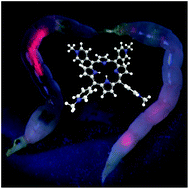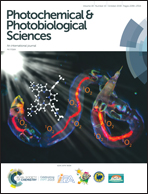Mosquito larvae control by photodynamic inactivation of their intestinal flora – a proof of principal study on Chaoborus sp.†
Abstract
Mosquitoes are carriers of dangerous infectious disease pathogens all over the world. Owing to travelling and global warming, tropical disease-carrying species such as Aedes, Anopheles and Culex spread beyond tropical and subtropical zones, even to Europe. The aim of this study is to investigate the potential of photodynamic agents to combat mosquito larvae. Three different photosensitizers were tested on Chaoborus sp. larvae: TMPyP and TPPS as antimicrobial photosensitizers, and mTHPC as a PDT drug against eukaryotic animal and human cells. Chaoborus sp. is a commercially available harmless species developing translucent larvae similar to the larvae of Aedes, Anopheles and Culex. The uptake of photosensitizers by the larvae was tested by fluorescence microscopy. All tested photosensitizers were observed in the intestinal tract of the living larvae, and none of the photosensitizers was found in the larval tissues. In phototoxicity tests, mTHPC and TPPS did not have any effect on the larvae, while TMPyP killed the larvae efficiently. TPPS is an antimicrobial photosensitizer, mainly phototoxic to Gram-positive bacteria. TMPyP is well known as an efficient photosensitizer against Gram-negative bacteria like most species of the intestinal flora. From this result, we conclude that the photodynamic inactivation of the intestinal flora leads to the death of mosquito larvae. The feasibility of mosquito larvae control by photodynamic inactivation of their intestinal flora instead of the direct killing of the larvae is a promising alternative to other highly toxic insecticides. Compared to insecticides and other biochemical toxins, photosensitizers are not dark toxic. No resistance against photosensitizers is known so far. Thus, the dilution of the active substances by being distributed in the environment, which promotes the development of resistance in biocides of all kinds, does not pose danger. Thus, it reduces the potential side effects on environment and human health.

- This article is part of the themed collection: New and innovative applications of Photodynamic Inactivation of microorganisms


 Please wait while we load your content...
Please wait while we load your content...